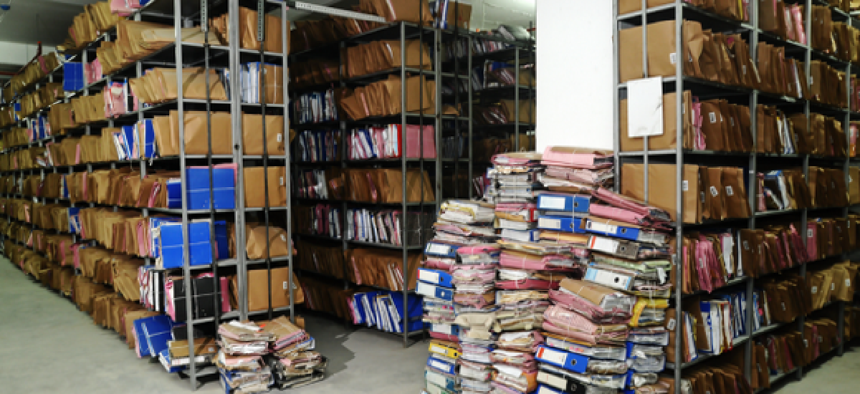Best practices for digitizing historical books and paper documents

Structured, educated digitization ensures collections remain useful and accessible for the future.
This spring's COVID-19 stay-at-home orders made the need for digital access clearer than ever. Public- and private-sector organizations were forced to scramble to keep working despite closed offices, and some were more prepared for the shift to remote work than others.
All organizations, no matter the industry, need records of their physical resources, and agencies that offered digitized versions of those resources, accessible online, found the necessary transition easier to navigate. Digitization is the best method of preserving books and other paper documents, but paper is a delicate material, and undertaking a digitization project is not as simple as it may seem.
A lack of digitization now might mean a complete halt in business and research when unexpected closings occur. These must-know best practices will help agencies begin a digitization project and decide what factors they should consider before starting.
First steps
No two digitization projects are the same, but they have one thing in common: they all require a certain amount of planning. Developing a plan entails organization of paper materials and a vision for the final digitized product. Is a searchable database with cloud access for all the employees in the organization required or simply a digital image backup in case a disaster destroys the originals?
Agencies will want to know everything they possibly can about their collections. How many items and of what types: loose-leaf, bound books, photos. They must also know how much they are willing to invest in this project, both in time and money, and decide on whether to invest in new scanners or monitors or outsource some of the project.
The Federal Agencies Digital Guidelines Initiative (FADGI) is a great starting point for learning about digitization. Personal projects aren’t too difficult to jump into for those inexperienced in scanning techniques and preservation methods. However, for agencies with a wealth of materials or a collection that is too delicate or deteriorated to scan in-house, partnering with a seasoned digitization vendor might be the best option.
Storage
How books and historical documents are stored makes a big difference in how well they hold up over time. But storage may be the last thing agencies consider when they’re itching to get started on their own digitization project -- after all, isn’t the point of digitization to shift from paper documents to virtual ones?
Considering storage options ahead of time will streamline the digitization process, allowing storage of materials properly once they’ve been scanned. Paper materials should be stored in archival-grade, acid-free boxes or folders. Any papers that have been exposed to potential contaminants (moisture, mildew, etc.) should be kept away from other materials to prevent spreading damage. Books and other bound documents should be stored flat to preserve the binding. Avoid the temptation to stack boxes. Storage enclosures should remain at or near room temperature (68 to 70 °F) with humidity as low as possible. Climate-controlled storage facilities are a good option for documents that agencies plan to keep but don’t need in the office.
Workspace and handling
Since paper can be extremely fragile, handling books and historical documents must be approached carefully. Minimal handling guarantees a document will have a longer life, adding another benefit to digitization.
The physical area where paper documents are scanned is more important than one might think. The digitization workspace should be free of any dust, dirt or any other contaminants. Staff should never eat or drink around materials they’re digitizing and wash their hands when necessary. Staples, paperclips or tape should be removed before scanning.
Archival-quality tools may be necessary, especially if the project involves working with old documents that are brittle or damaged. Archival spatulas can secure books in a cradle scanner, and tweezers may help remove any adhesives before scanning. White cotton or nitrile gloves will protect photos and other delicate materials from oils or fingerprints.
Scanning
Choosing a scanning method that doesn't damage books or historical documents is a top priority. Not all scanners are created equal, and agencies may have to do a bit of research to make sure their hardware is up to the task. For instance, the scanner bed must be larger than the material being scanned. FADGI guidelines can help agencies verify their scanner settings are appropriate for the project and materials they’re working with.
Bound materials often can’t be scanned in a flatbed scanner, and unless agencies are willing to split a book’s binding to feed through or lay flat in a scanner, they’ll have to find another solution. This may be a state-of-the-art cradle book scanner or a DIY construction of cameras, book wedges, lights and cardboard.
Every collection has its own challenges and goals, and a digitization plan may need to adapt over time as agencies get a feel for the needs of the project. Whether scanning in-house or working with a professional archival team, the key to a successful digitization project is planning ahead and knowing how the digital collection will be used. Doing it wrong the first time will only lead to a poor-quality product that will cost more to fix later. Structured, educated digitization ensures an organization’s collection remains useful and accessible for the future.
NEXT STORY: Tracking COVID in homeless populations





